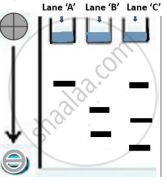Advertisements
Advertisements
Question
The DNA molecules of the same size were extracted from E. coli and Plasmodium vivax. It was discovered that both the DNA molecules had one target site each for the restriction enzyme Hind II. After being digested with Hind II, the DNA fragments were subjected to gel electrophoresis.
With reference to the diagram given below, identify the lanes that represent the DNA fragments of E. coli and Plasmodium vivax respectively. Justify your answer with a reason for each.

Solution
Lane A – DNA of E. coli
Lane B – DNA of Plasmodium vivax
Because the circular DNA of E. coli was cut to release just one fragment, while the linear DNA of Plasmodium was cut to release two fragments.
APPEARS IN
RELATED QUESTIONS
Describe the experiment that helped demonstrate the semi-conservative mode of DNA replication.
Draw a labelled diagram of a “replicating fork” showing the polarity.
Draw a diagrammatic sketch of a portion of DNA segment to support your answer.
Why is it not possible for an alien DNA to become part of a chromosome anywhere along its length and replicate normally?
How was a heavy isotope of nitrogen used to provide experimental evidence to semi-conservative mode of DNA-replication ?
Escherichia coli fully labelled with N15 is allowed to grow in N14 medium. The two strands of DNA molecule of the first generation bacteria have ______.
Out of 8 ascospores formed in Neurospora the arrangement is 2a : 4a : 2a showing ______.
Okazaki fragments are seen during ______.
If Meselson and Stahl's experiment is continued for sixth generations in bacteria, the ratio of Heavy strands 15N/15N: Hybrid15N/14N: light 14N/14N containing DNA in the sixth generation would be ______
The origin of replication of DNA in E. coli is shown below, Identify the labelled parts (i),(ii), (iii), and (iv)

